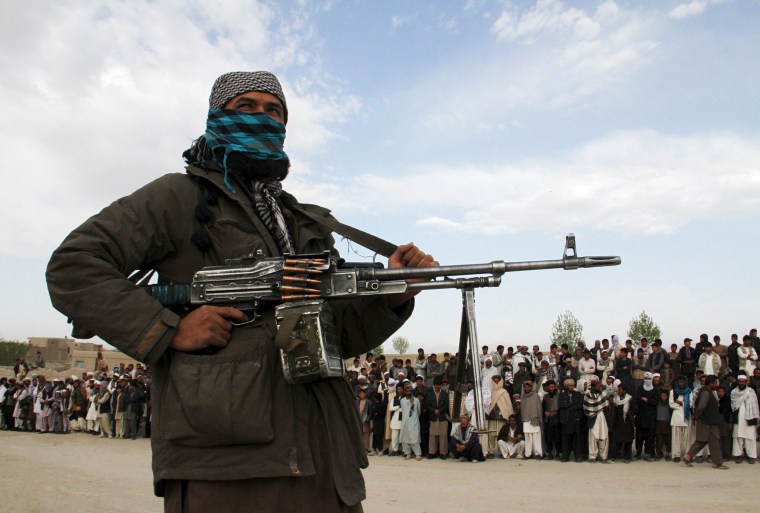The Afghan Taliban is struggling to maintain a unified facade amid reports of splits within the group and some of the militants fighting each other in the east of the country.
According to two commanders within the Taliban — which has been fighting an insurgency against the Afghan government and foreign forces since being toppled by the U.S.-led invasion in 2001 — and two Afghan intelligence officers, the group has splintered into at least three parts.
The groups roughly are those still loyal to the original Taliban, others fighting under the name of ISIS and those who want to lay down arms and join the peace process with the Afghan government, a Taliban commander told NBC News on condition of anonymity.
“The Afghan Taliban who want to continue to fight are led by Mullah Omar," he said, referring to the shadowy figure who ran the organization throughout its time in government. "Those who don't want to have joined [ISIS] ranks, and the pro-talks elements could be seen in Kabul on the side of the government."
Related: Talking to the Taliban: Everything You Need to Know
Afghan intelligence officials also say they believed that rifts had opened up within the militant group.
“The cracks in the ranks of Taliban began late last year with the emergence of Daesh in the region," a senior Afghan intelligence official told NBC News on condition of anonymity, calling ISIS by the another name. "The first big defection [from Taliban] to Daesh was senior Taliban commander Abdul Rauf Khadin ... who was killed in a joint operation with U.S. forces a few months ago."
Reports of infighting among militants and ISIS making inroads in to Afghanistan surfaced after the announcement in January by ISIS of creation of a council for the province of Khorasan — a historic name of the territory covering modern-day Afghanistan, Pakistan and surrounding areas.

Anthony Cordesman, who analyzes Afghanistan at the Center for Strategic & International Studies, said divisions within the Taliban are nothing new. Fractures date back to the start of the 2001 American invasion, when the leader, Mullah Omar, went into hiding.
"There have always been those more hardline than Omar, and there have always been people who want to compromise," Cordesman said. "And there have always been questions about the extent to which the factions who say they want peace actually want peace or want to use negotiating tactics to undermine the government."
Reports of the latest splintering come as the Taliban’s spring offensive picks up steam and violence spreads to parts of the country that had remained peaceful for most of the past decade-and-a-half. They also come amid intensifying efforts by the Afghan government to start direct peace talks with the militant group.
A provincial government spokesperson in eastern Nangahar province has told NBC News that over 100 families have been displaced and over 150 militants have been killed in the infighting between militants loyal to ISIS and the Taliban in the past three weeks in some of the remote districts of the province bordering the lawless tribal areas of Pakistan.
Related: Afghans Find ISIS-Linked Fighters Worse Than Taliban
On Tuesday, a stark indication of the rifts opening up between commanders and fighters came in the form of a rare open Taliban letter to ISIS.
In it, the Taliban warned ISIS to “stay out of Afghanistan," and was the first time Taliban have indirectly acknowledged the ISIS threat to its grip on the 15 years insurgency in Afghanistan.
The letter — signed by the second in command Mullah Akhtar Mohammad Mansour — said the group’s unity was its biggest success and warned that "if there are attempts to create separate jihad fronts, it will become the cause of in fighting and division within the ranks of Mujahedin."
A U.S. government expert played down the notion that ISIS is causing significant schism.
The expert, who spoke on condition of anonymity, pointed to an incident in Nangahar province, where the Taliban put down attempts by a small group of Taliban to jump to ISIS. In that case, ISIS may have overstepped its bounds, the expert said.
The expert contrasted that response to that of the Iraqi Army, which regularly runs away from a fight with ISIS forces.
Related: Brutal ISIS Beheadings Spread to Afghanistan
With Mullah Omar not seen in public since 2001, the group has been run by top lieutenants often competing over power, according to intelligence experts and sources within the militant group. Cordesman described the appearance of division as "people who have been looking for leadership" in Omar's absence.
In April last year, Mullah Qayum Zakir, a former Guantanamo inmate and the group’s top military commander was pushed out over differences with the Omar’s deputy, Akhtar Mansour. “The differences between top Taliban leaders ... have divided the group,” an Afghan intelligence official added.
The open letter has prompted militants to ask questions about Omar, and why Mansour issued the statement while Omar is alive.
"This is first time the deputy has issued statement on such an important issue. Why not our spiritual leader Mullah Mohammad Omar?" asked one of Taliban’s members in Afghanistan's eastern Kunar province.
"ISIS and its fighters are fully active these days in Afghanistan and our people are joining it in large numbers in eastern parts. They were loyal to Mullah Omar but now if he is either out of the scene or continue his long silence, it will further damage our struggle against the foreign forces in Afghanistan," the militant told NBC News.
However, the divisions don't seem to be hurting the Taliban's ability to fight, Cordesman said. The group has been exerting more influence, and killing more people, in places where it hadn't previously been active, he said.
"The Taliban may be tired. It may have divisions over who the leader is," Cordesman said. "But by measure of activity, areas of influence, the numbers of incidents and casualties, they're having significant success."
